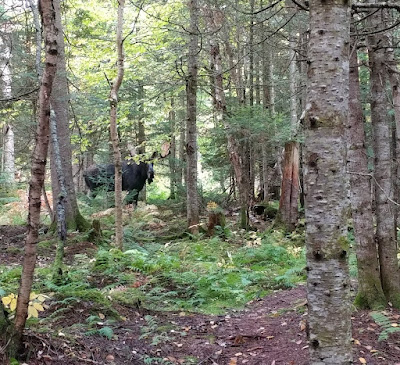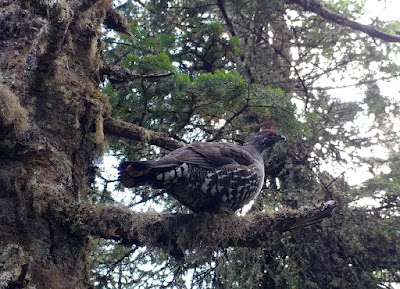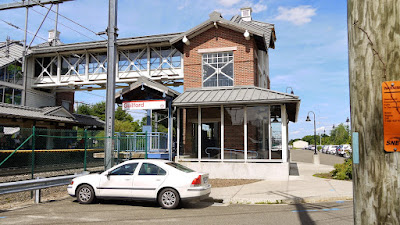 |
| Moose on the Cohos Trail in "Moose Alley" |
I don't have the best photos, but if you're wondering what kind of wildlife you might encounter hiking the NET-Cohos route, this page is for you.
There were three other times I heard moose along the trail. One was camping on Mt. Sunapee (on the M-S Greenway), when I heard one speeding down the trail past my tent at night (the trail was plastered in poo and tracks). The second was up in Moose Alley when I heard a moose calling down in a swamp below. The last was in the White Mountains. While scouting for a place to hang my bear bag one evening, I came to an active 'moose scraping' about 100 feet from my tent. This is where bull moose in rut scrape the ground and leave their scent by peeing all over it. As soon as it got dark, I heard the moose over there stamping and scraping up a storm. I was a little nervous being in a flimsy tent so close to a rutting moose, but I've never heard of a moose attacking a tent.
 |
| The bear I just chased away from my tent in Connecticut's Bear Alley |
 |
| White-Footed Mouse on the NET |
 |
| Porcupine, Fauver East Trail, Plymouth, NH ("Ghost Trail") |
 |
| Black Rat Snakes are typically 4-5 feet long, but harmless |
 |
| Spruce Grouse, Cohos Trail, Kilkenny section |
 |
| Turkey are mostly seen from the road |
Turkey are common along the route from end to end, but there seem to be a lot more of them after you leave the trap rock ridges behind. Northern Massachussetts to central New Hampshire seemed to have the most. I didn't see many turkey in the woods, but walking or driving along the roads there were often large flocks. The house we rented near Sunapee was visited by a flock of 35 turkey. I don't know why there were so many more turkey in these areas. Maybe a combination of plentiful oaks & beech along with possibly fewer coyote?
Ravens make some of the weirdest noises in the forest. I saw and heard plenty of raven especially near areas with cliffs.
I'll give a shout out to the Bald Eagle that swooped down and almost hit our windshield as we were headed up I-91 in Massachusetts for a weekend of hiking the trail. We missed the eagle by inches. Wow, they are big. The Connecticut River was nearby, and the eagle was probably hunting both the river and the highway.
Newts: The Red Eft is a hiker favorite, often found on trails during wet weather. I had a day in New Hampshire where I walked over more than a hundred of these tiny amphibians. It was hard not to step on them. I didn't encounter any of these north of the White Mountains, or at the higher elevations, and there may be fewer along the dry trap rock ridges of Connecticut. The sweet spot seemed to be northern Massachusetts and southern New Hampshire. The Red Eft is interesting in that it's the terrestrial phase of the Eastern Spotted Newt. The aquatic stage looks completely different, being a drab olive color a flattened tail like a fish. Although the Red Eft stage is typically thought of as the adult stage, this newt can actually revert back to the 'juvenile' aquatic stage if conditions are favorable.
 |
| Red Eft stage of the Eastern Spotted Newt |
Walking past a tiny mud puddle near the northern end of the NET in Massachusetts, I came upon a swarm of nineteen newts, presumably breeding. This was on an unmaintained dirt road that gets a lot of off-road vehicles. Just a puddle in the tire ruts.
 |
| Red Efts swarming in a mudhole |
Squirrels & Chipmunks: I had a Red Squirrel jump on my leg. I was standing very still on the Crawford-Ridgepole Trail ("Ghost Trail" option) pondering something, when the squirrel came bounding up the trail. Jump-pause-jump-pause, getting closer and closer until it jumped right onto my leg. It quickly realized its mistake and scurried off. I could feel his little claw marks in my skin for half an hour. Hard to say which of us was more surprised. You'll see lots of Grey Squirrels and Red Squirrels along the NET-Cohos, the former in areas with a lot of oak trees (southern/lower elevations) and the latter in areas with spruce and pine (northern/higher elevations). Chipmunks are just everywhere, which you might not notice unless you're walking a leashed dog who hopes to catch every single one of them.
Fox: I saw a Gray Fox at the base of Mt. Moosilauke. I've encountered many Red Fox in Connecticut (sometimes napping in my backyard), but never a Gray Fox. Red Fox are not originally from New England, but came down from open areas of the Arctic and have adapted really well to farms and suburbs. Gray Fox were the original (native) New England fox, but they need dense forests to thrive, like the forest on Moosilauke. So it was a treat to finally see one.
 |
| Deer in Connecticut will freeze and watch you walk past |
Deer: There are a bazillion White Tailed Deer in Connecticut. There's an inverse relationship between moose and deer as you go north, so if you're in prime New Hampshire moose habitat, you probably aren't seeing many deer. But in Connecticut, which only rarely sees a moose passing through, there are so many deer that they cause a lot of damage to the forests. They will typically freeze as you walk past, not panic and jump through the forest like they do in areas that heavily hunted. Therefore there's a good chance of not noticing them while hiking unless you're really looking. Having said that, the NET does pass through areas open to hunting, so wear your orange if hiking in the fall. There are poachers who don't respect hunting seasons or property lines. On the nearby Shenipsit Trail one October, a poacher shot a backyard deer near the trail as I was approaching. The lung-shot deer ran a short ways and dropped right on the trail. It wasn't firearm season for deer yet, but I had my blaze orange hat on just in case and was glad for it.
 |
| Hermit Crab in Long Island Sound |











